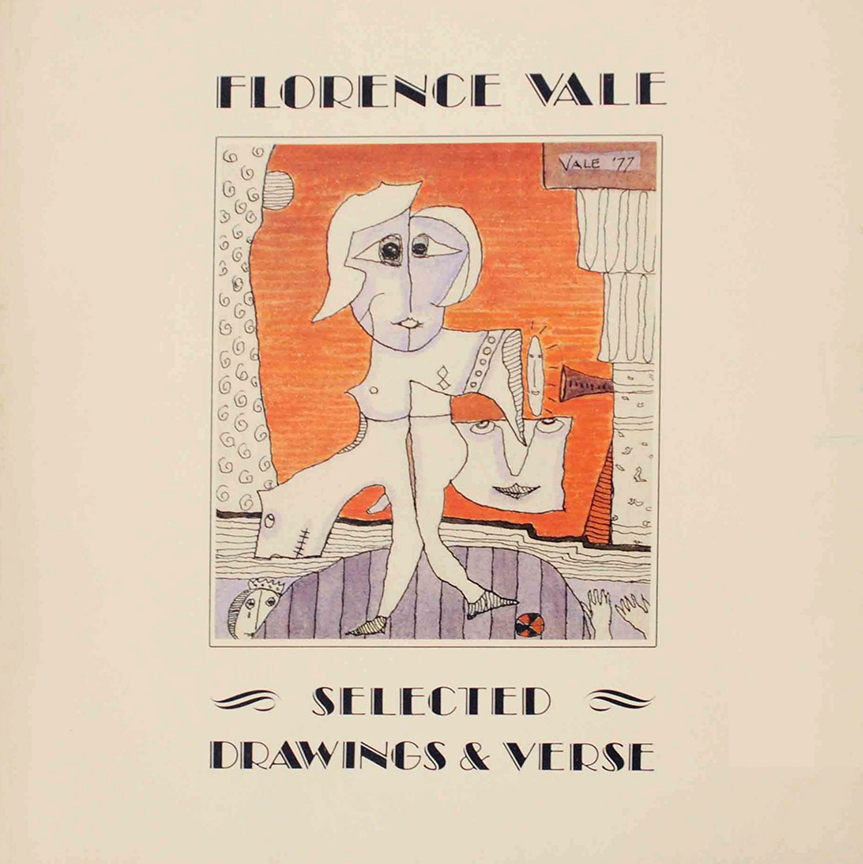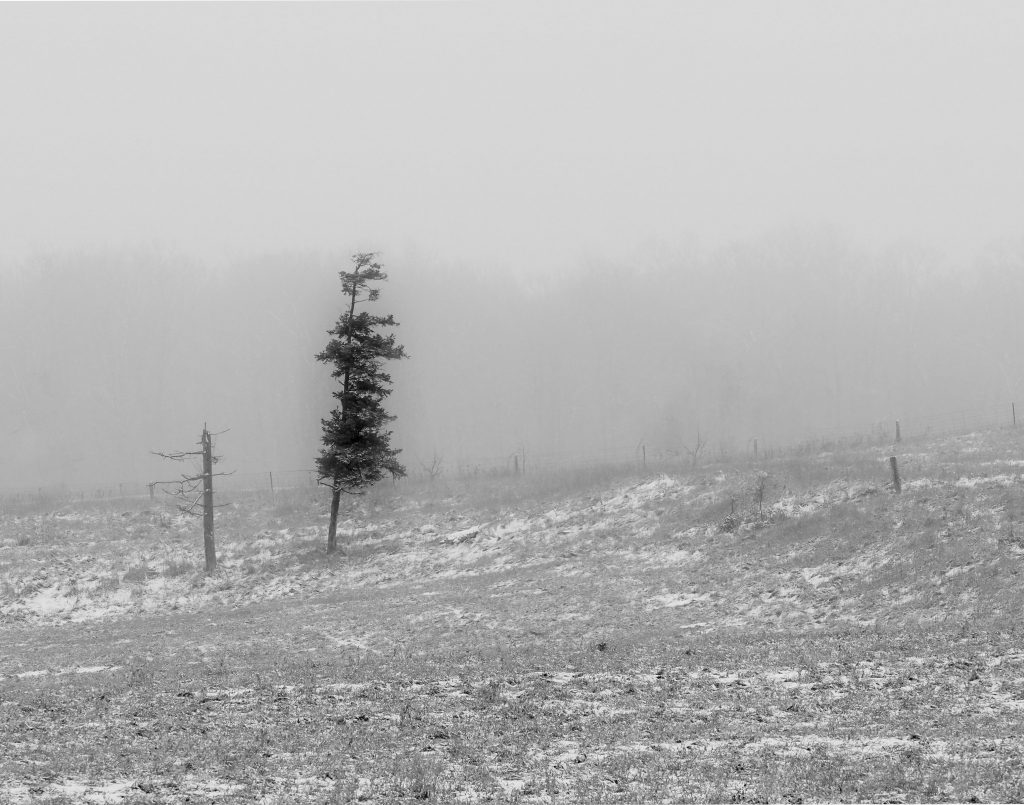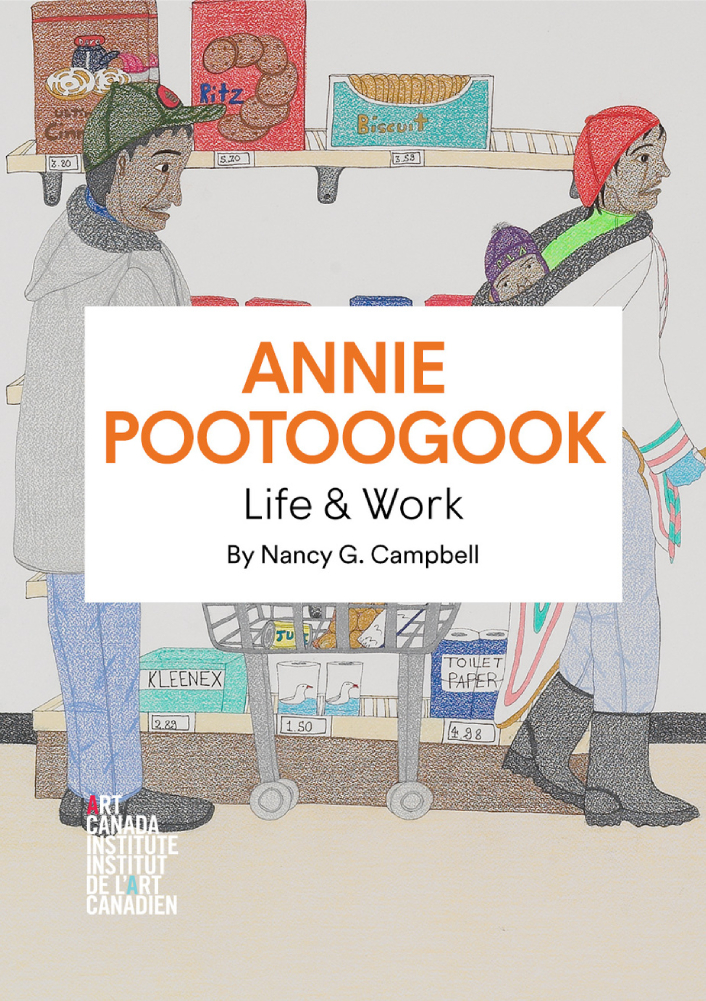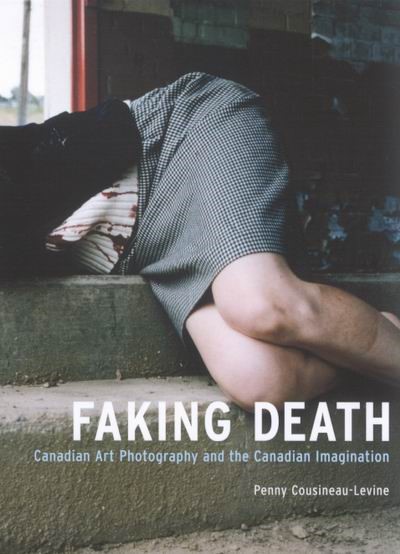In: Canadian Art

Yuka Yamaguchi | Inseparable | 2006
July 14, 2023Yuka Yamaguchi | Inseparable [離れられない] | 2006
If there is love, smallpox scars are as pretty as dimples.
(Japanese proverb)
There is a simple elegance to Yagmaguchi’s work that sometimes belies the visceral content. I was lucky enough to experience her work in person, in an exhibition years ago that purported to showcase contemporary Saskatchewan artists. There were too many artists in the show, some of middling ‘quality’, but Yamaguchi’s unique style and subject matter was a high point of that exhibition.
Her use of very simple tools is perfectly matched to the illustrative nature of her images, which are as much about storytelling as a disciplined but playful aesthetic.
The title of this work can also be translated from Japanese as ‘Can’t Leave’ : but I don’t interpret that in a negative context, and still read this work as a more bodily or corporeal valentine’s card. The rawness is just another way of depicting the intensity of the feelings of being ‘inseparable.’
Yuka Yamaguchi is a self-taught visual artist from Kobe, Japan who has lived in Saskatoon since 2005.
Colour pencils and paper are her preferred medium as these tools allow for strong colors even though they are fragile and delicate. Yamaguchi “draws intuitively as she sees an image appear on paper and keeps adding images like a puzzle.”
More of Yuka Yamaguchi’s artwork can be seen here.
~ Bart Gazzola
Read More
Dan Kennedy / Dr. Erosion | Animations, 2019 – 2022
December 15, 2022Dan Kennedy / Dr. Erosion | Animations, 2019 – 2022
I’ve always been a fan of animation in its many forms (I am a member of Gen X, so Saturday morning cartoons shaped me, but I also remember watching Science Ninja Team Gatchaman – and the butchered Western version Battle of the Planets when small, and Akira [アキラ] is another seminal experience, for me, when young).
Speaking as a more mature viewer, The Brothers Quay’s Street of Crocodiles (1986) is something I can watch over and over: and recently I rediscovered the 1986 animation The Mysterious Stranger, from the larger film The Adventures of Mark Twain (that vignette is based on Twain’s ominous story of the same name). The shifting mask of Satan, in that claymation, disturbed me as a child and still horrifies me now. Perhaps, with stop action animation, there’s that same ‘perversion’ of the human body that we see in work with dolls, as I touched upon when responding to Gabrielle de Montmollin’s Weird Baby World installation.
When I began researching Dan Kenndy / Dr. Erosion’s work, I was mostly familiar with his two dimensional ‘still’ artworks, but soon became engrossed with his short ‘films’. Drawing Time, Cats Dream of Water, Where is the Blue Fairy? – and many others – are brief visual anecdotes, amusing and disturbing simultaneously.
The images below are teasers for the longer works, which can be enjoyed here (works from 2019) and here (works from 2020 – 2022).
Kennedy’s aesthetic is ghostly ethereal and densely complicated, pulling upon his continuing “explorations of commercial culture or as he refers to it, ‘the commercial unconscious”.” (from here) There are hints of Hieronymous Bosch in these brief vignettes from Dr. Erosion / Kennedy that are engaging but also eerie.
When I’ve written about abstract painting I’ve often stolen and shared an idea from art historian Julian Bell: ‘In other words there was no prior context to the painting itself. The viewer’s eyes would submit, and the painting would act.’ Kennedy’s works are often short, and this makes them even more focused – like a sharp taste, where more would be too much.
Dan Kennedy / Dr. Erosion was also a previously featured Artist You Need To Know in AIH Studios’ continuing series. That can be explored here.
IG: @dr.erosion
https://www.dankennedy.ca/
More animated works from Kennedy / Dr. Erosion can be found on VIMEO.
~ Bart Gazzola
Read More
Florence Vale | Selected Drawings & Verse, 1979
November 3, 2022Florence Vale | Selected Drawings & Verse, 1979
Published by Aya Press, Toronto, Ontario, Canada, 1979
My love created
something more real than you are
how disappointing
Florence Vale was an artist influenced equally by surrealism, expressionism and cubism, melding these sometimes disparate movements into unique works. “I paint what I dream,” Florence Vale (1909 – 2003) stated, and the late art historian Natalie Luckyj offered that “Her art was a world in which fantasy and reality are interwoven to create a private and secret environment.”
She published several books of her writing intermixed with her artwork: in this slim volume, the drawings are linear and simple, and often erotic. The text alternates between a light-hearted salaciousness and more stark, desolate meditations upon love.
Vale was a previously featured artist in AIH Studios’ ongoing series of Artists You Need To Know. That can be enjoyed here, where you can see more of her artwork.
A light went out
and I can’t turn it on
the dark is frightening
engulfing
temptation is rife
a momentary relief
leaving regrets
and the pain is there still
but deeper now
despair strains the heart
longing is agony
God’s love cannot compensate for yours
This is not an easy book to find, though you may be able to procure it online through spaces like this one. But – as I so often do – I would suggest your local library, or a local second hand book store, as they have been – and continue to be – treasure troves of fine art books. I discovered this book in the library at AIH Studios, but also have a copy of another of Vale’s publications of prose and pictures that I bought at an artist run centre’s ‘yard sale.’
I must also inject that there are too few collections of artists’ books and publications that are accessible to all, in gallery and museum spaces, and this is an unfortunate consequence of the prevalence of digital spheres, now….
~ Bart Gazzola
Read More
Philip Monk | Is Toronto Burning?: Three Years in the Making (and Unmaking) of the Toronto Art Community
July 7, 2022Philip Monk, Is Toronto Burning?: Three Years in the Making (and Unmaking) of the Toronto Art Scene, London: Black Dog Publishing, 2016.
Jack Pollock, Dear M: Letters from a Gentleman of Excess, McClelland & Stewart, 1989
“Each day I write. I’m not sure what it’s all about, but most days I write about art and the constant raping of its values by pseudo intellectual acrobats.” (Jack Pollock, Dear M: Letters from a Gentleman of Excess)
Nothing seems more improbable than what people believed when this belief has gone with the wind. (Doris Lessing, The Golden Notebook)
“Culture has replaced brutality as a means of maintaining the status quo.” (Philip Monk, Is Toronto Burning? Three Years in the Making (and Unmaking) of the Toronto Art Scene)
A spate of old issues of FILE magazine came into my hands over the past year (it’s worth noting that they were a gift from Elizabeth Chitty, who also gave me the copy of Monk’s book that spurred this essay). They’re a bit ragged, but that seems appropriate, as they’re like flashbacks (the magazine began publishing in 1972 and ran for 17 years, with 26 issues) that don’t resonate with many, more nostalgia than substance.
They seem very dated, at times very juvenile, and more of an exercise in artistic onanism than anything else. This is, of course, a generalization, and it’s broken in certain points quite clearly. The issue that is almost entirely colour images of the three poodles, one of the many symbolic personas of General Idea, engaged in various tumbling and enthusiastic sex acts is one to keep (as I was impressed when I saw one of the large paintings from this series on a trip to the Art Gallery of Hamilton, installed amidst other notable Canadian works from Graham Coughtry to Attila Lukacs).
But many of the other copies of FILE are easily dismissed, even by someone like myself who has made a career of excavating in spaces that are too often ignored as pertains to Canadian Art history. The odd flash of brilliance, or the appropriation of mainstream media narratives and iconography, the sampling of authors from Burroughs to Acker, are the exception, not the rule.
Perhaps, this many decades later, our expectations of how artists engage in appropriation is more sophisticated – or more jaded. Edit as you will.
But all this reminded me of my long overdue response to Philip Monk’s book Is Toronto Burning? Three Years in the Making (and Unmaking) of the Toronto Art Scene), published several years ago, and that is focused upon the same era. I found the book uneven, and some players and characters in this story seem somewhat incongruous to their later roles or personas (true or assigned, in that vague way of art history and cultural narratives). But Monk’s own words lead to this: “In a sense, what follows is a story, a story with a cast of characters. These characters are pictured in video, photography, and print – not necessarily as portraits but rather as performers.” (from the chapter 1977). But in finally offering my impression of Monk’s narrative (considering personal and public factors and all the sites where those contested narratives collude and collide), I’ll begin with the following assertion: “All narrators are unreliable. Especially when they are characters within their own story.”
Read more here.
Read More
Essay – Ron Hewson – Community Galleries
March 1, 2022Community Galleries
I’ve been putting a lot time and effort lately into a community gallery that I belong to. While doing this I’ve put some thought into why I feel it’s worth the effort. Here are some of my reasons to to belong to and participating in this endeavour.
I believe it’s important for local artists to have a place to hang their work. Putting my work on a wall in a public space means I feel that I have created something that is worthy of public display. This matters because the emotional investment in producing art needs that outlet. Showing in a gallery is the reward for the time and money put into our work. I know I would continue to work regardless of belonging to a gallery but knowing that I can share what I have made is incentive to keep working.
Belonging to the gallery means I have to finish things. Every couple months I need new framed finished work to display. As a photographer I can capture a vast number of images. However that really doesn’t mean anything if I don’t finish any of them. Sure I can do some quick editing and post them on Instagram or do some more careful work and post on a stock photo site but that’s not the same as taking the extra steps to print and frame something. The incentive to finish work is a big benefit of belonging to the gallery.
Preparing work for the community gallery on a regular basis is far less stressful that preparing for a major gallery show. I’ve done shows at “big” galleries. The thrill and sense of accomplishment that comes from that kind of show can’t be beat. But the investment in time and money can be overwhelming. Its not something that everyone is prepared to do or is willing to do and for most people its out of reach. The community gallery fills that need perfectly. It gives the opportunity to exhibit that is manageable for artists who want to exhibit without the stress of a solo show.
There are many other reason the gallery is worth my time such as the diversity of the art on display and the camaraderie of follow artists but what makes to gallery valuable to me is the incentive to keep working. I believe that everyone needs some form of incentive and that for me is to have my photography physically present in the world. While posting something online might get seen by lots of people we don’t paint or sculpt or create our art to be seen on a phone.
Visit uptowngallerywaterloo.com
~ Ron Hewson
Read More
dream listener | karen elaine spencer, 2006 – 2007
February 4, 2022dream listener | karen elaine spencer, 2006 – 2007
In a dream I saw a way to survive and was filled with joy. (Holzer)
I have dreamed a dream, but now that dream is gone from me. (The Matrix: Reloaded)
i wrote my dream on cardboard, went out into the street and held the cardboard dream in front of me. at the end of the day i abandoned the cardboard dream. over the year one hundred and ninety-four dreams were written on cardboard and shared this way. (karen elaine spencer)
There is a poetic brutality to karen spencer’s dream listener porteur de rêves works, and especially several that she’s shared online recently, looking backwards at this series. (The image I’m sharing here is from 2007)
These are stark images, both visually and in terms of what spencer has chosen to present. spencer and I became acquainted when she exhibited a postcard/billboard project (using an image taken from her first invitation with ATSA’s l’État d’urgence) in Saskatoon some time ago; we joked about how both of us liked to walk in the frigid temperatures of our respective cities, and how that gave us a different sense of the place and the people. spencer often seems to notice things that others ignore, in these images: sometimes those are discarded objects. Often they are detritus, or indicators, of discarded people. spencer’s work is very political, and often in the public sphere, as well.
“Her work questions the hierarchy inherent in use values and investigates how we, as transient beings, occupy the world we live in. The widely held belief in a linear movement forward, or “progress”, is confronted through her repetition of actions that lead nowhere. Rambling, dreaming, loitering and riding the metro are all activities spencer has previously undertaken as part of her practice. Actions are sustained over time (often a year or more) rendering her artistic practice indistinguishable from her daily life. She works with what is near at hand, materials that speak of our day-to-day existence: cardboard, oranges, bread, chalk. Through a détournement of materials or intentions spencer intervenes into spaces; hoping to shift, even if only ever so slightly, our perceptions of what is possible.” (from The New Gallery)
spencer’s words are plaintive yet engaging. There’s a sadness evoked that seems to speak to you, on a very personal level. Her other texts in this series are equally melancholic: I dreamed my insides were falling out astride a pile of domestic discards, i dreamt i wanted nothing more to do with death, i dreamt i was waiting but i don’t know what for and i dreamed i lay in a puddle and watched the rain fall on me (the latter two both on wood that we all recognize as that used to board up windows, an arbiter of damaged, empty – unwanted – spaces).
More of the dream listener interventions can be seen here. More contemporary works by spencer can be found on her IG feed: @karenelainespencer
~ Bart Gazzola
Read More
Annie Pootoogook | Life & Work
September 30, 2021Annie Pootoogook | Life & Work by Nancy G. Campbell
The Art Canada Institute has produced a number of fine books (all readily available at their site) on various artists that have informed and challenged the larger Canadian art world.
Nancy G. Campbell’s “Annie Pootoogook: Life & Work traces the artist’s life from her youth at the West Baffin Eskimo Co-operative’s Kinngait Studios, where she began drawing in 1997, predominantly in ink and crayon, to her death in 2016. The book explores how in addition to depicting scenes of everyday life in the North—including people watching TV, playing cards, shopping, or cooking dinner—Pootoogook depicted such subjects as alcoholism, domestic abuse, food scarcity, and the effects of intergenerational trauma.”
There is a certain bluntness and brutality, at times, to Pootoogook’s scenes. Campbell’s engaging but also rigorous examination of Pootoogook’s life and work (as they were, frankly, one and the same) explores how “the life of Annie Pootoogook (1969–2016) tells an important national story, and her career marks a pivotal shift in the national consciousness around contemporary Inuit art. With a keen eye for detail and fearlessness in representing daily life—the celebratory, the frightening, and the mundane—she captured the attention of Southern audiences. Although imported culture and technologies have dramatically changed Inuit life, the North has also stayed true to tradition: community, food, and language remain sources of Inuit pride. In her drawings, Annie depicted what is still valued and unique in her culture and what is changing rapidly. She had a meteoric rise in the art world that was tragically cut short when she died in 2016.”
I encountered Pootoogook’s work at the Mendel Art Gallery (now the Remai Modern) in Saskatoon in 2009. The simplicity and directness – the truth, both celebratory and unsettling – of her images resonated in that place. From the legacy of residential schools that dotted the prairies, to the Saskatoon police’s starlight tours, to the ongoing shameful dismissal of murdered and missing Indigenous women, Pootoogook – though from Cape Dorset – was very loud, in Saskatchewan, and even posthumously has a power to disrupt our assumptions and ignorance.
Annie Pootoogook: Life & Works, a publication from The Art Canada Institute, can be read here.
More about Pootoogook can be read here.
Read More

Interview with Julia Huỳnh
November 3, 2021Touching on topics such as the family archive, destruction of the self-portrait, consent and authorship in photography, and more, Guest Curator Julie Dring interviews Toronto-based archivist and photographer Julia Huỳnh. Click for more!
Read More
Faking Death
July 24, 2021Penny Cousineau-Levine
Faking Death
Canadian Art Photography and the Canadian Imagination
McGill-Queen’s University Press
Penny Cousineau-Levine’s “Faking Death” is considered by many to come closest to defining the characteristics of “Canadian” art; specifically the photographic arts but her conclusions can be applied to visual, performing and literary arts as well. She posits that the photographs she used for her study (all artistic photos by a select group of artists taken between 1950 and the 1990’s) are rarely about the referent… as she puts it, “a pipe in Canadian photography isn’t usually a pipe. It’s probably a crucifix”. This “dislocation” is at odds with straight American documentary photography, where the “truth” of the image is its most important characteristic.
The book, although academic in tone (indeed it was written in an attempt to describe to her university students the notion of a Canadian tradition of art), is a captivating read and draws many more fascinating conclusions. Once enlightened by her observations, you can’t help but see the characteristics she lays out in almost every piece of Canadian work.
This book is a MUST read for all Canadian artists and art lovers. It is available at McGill-Queen’s University Press. ~ Mark Walton
Read More
Down the Old Bog Road: Frances Crossan Blanchard
October 14, 2021Our first Guest Curator Kim Fahner writes about the work of her friend Frances Blanchard. “When you stay in O’Neill Cottage, you see Frances sitting in front of you, but then can feel and sense a group of ancestors standing all around her, thanking her for bringing that homestead back to life. Her paintings, then, are full of details that conjure up stories of her family and the land they lived on.” Click for more!
Read More
Recent Comments